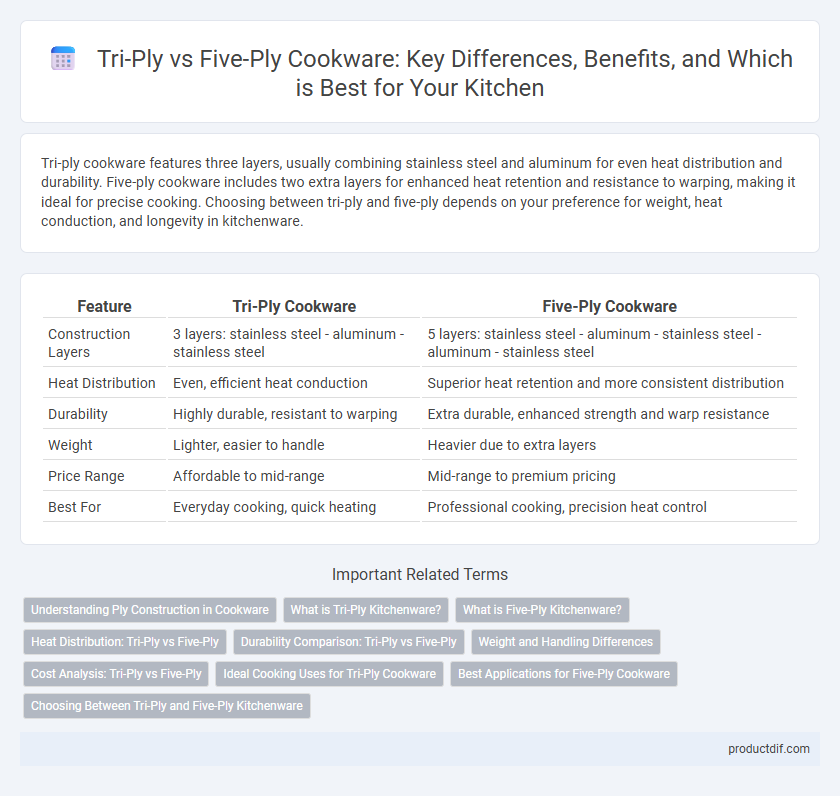Tri-ply cookware features three layers, usually combining stainless steel and aluminum for even heat distribution and durability. Five-ply cookware includes two extra layers for enhanced heat retention and resistance to warping, making it ideal for precise cooking. Choosing between tri-ply and five-ply depends on your preference for weight, heat conduction, and longevity in kitchenware.
Table of Comparison
| Feature | Tri-Ply Cookware | Five-Ply Cookware |
|---|---|---|
| Construction Layers | 3 layers: stainless steel - aluminum - stainless steel | 5 layers: stainless steel - aluminum - stainless steel - aluminum - stainless steel |
| Heat Distribution | Even, efficient heat conduction | Superior heat retention and more consistent distribution |
| Durability | Highly durable, resistant to warping | Extra durable, enhanced strength and warp resistance |
| Weight | Lighter, easier to handle | Heavier due to extra layers |
| Price Range | Affordable to mid-range | Mid-range to premium pricing |
| Best For | Everyday cooking, quick heating | Professional cooking, precision heat control |
Understanding Ply Construction in Cookware
Tri-ply cookware features three layers typically consisting of stainless steel and an aluminum core, providing even heat distribution and durability for everyday cooking tasks. Five-ply construction incorporates five layers, often alternating metals such as stainless steel and aluminum or copper, enhancing heat retention, strength, and responsiveness for advanced culinary precision. Understanding these ply constructions helps consumers choose cookware that balances heat conduction, weight, and cooking performance suited to their kitchen needs.
What is Tri-Ply Kitchenware?
Tri-ply kitchenware features three layers of metal, typically combining stainless steel on the outer layers with an aluminum core for even heat distribution and durability. This construction enhances thermal conductivity while providing resistance to warping and corrosion, making it ideal for precision cooking. Tri-ply cookware balances performance and affordability, favored in both home and professional kitchens.
What is Five-Ply Kitchenware?
Five-ply kitchenware consists of five layers of metal, typically combining stainless steel and aluminum to ensure superior heat conductivity and durability. This multi-layer construction provides even heat distribution, minimizing hot spots and enhancing cooking performance compared to tri-ply cookware. The outer stainless steel layers offer corrosion resistance and a polished finish, while the aluminum core boosts thermal efficiency for precise temperature control.
Heat Distribution: Tri-Ply vs Five-Ply
Five-ply cookware offers superior heat distribution compared to tri-ply due to its additional layers of metal, typically alternating between stainless steel and aluminum or copper, which enhance thermal conductivity and even heat dispersion. Tri-ply pans consist of three layers, usually stainless steel with an aluminum core, providing good heat distribution but less efficiency in maintaining stable temperatures. This difference makes five-ply more effective for precise cooking tasks that require consistent heat across the entire cooking surface.
Durability Comparison: Tri-Ply vs Five-Ply
Five-ply cookware offers superior durability compared to tri-ply due to its additional metal layers, which enhance resistance to warping and deformation under high heat. The extra layers in five-ply construction provide improved heat distribution and increased structural strength, extending the lifespan of the cookware. Tri-ply pans remain durable for everyday cooking but may show wear faster than five-ply options in professional or heavy-use scenarios.
Weight and Handling Differences
Tri-ply cookware typically weighs less than five-ply, making it easier to handle and maneuver during cooking. Five-ply construction, incorporating more layers of metal, adds weight which enhances heat retention and distribution but can feel heavier during use. This weight difference influences user preference, balancing between lighter, more agile pans and heavier, more durable options.
Cost Analysis: Tri-Ply vs Five-Ply
Tri-Ply cookware generally offers a more affordable price point due to its three layers of metal--usually stainless steel and aluminum--while Five-Ply cookware, featuring five layers for enhanced heat distribution and durability, commands a higher cost reflecting its advanced construction. The price difference often correlates with brand reputation and material quality, where Five-Ply sets target professional chefs or serious home cooks investing in long-term performance. Consumers should weigh initial investment against cooking efficiency and longevity, as Five-Ply can reduce energy usage and improve cooking results, potentially offsetting the upfront expense over time.
Ideal Cooking Uses for Tri-Ply Cookware
Tri-Ply cookware offers excellent heat distribution and durability, making it ideal for everyday cooking tasks such as sauteing, frying, and simmering. Its construction, typically combining stainless steel with an aluminum core, ensures even heating while maintaining compatibility with induction cooktops. Home cooks benefit from Tri-Ply cookware for preparing vegetables, meats, and sauces with consistent temperature control and reduced hot spots.
Best Applications for Five-Ply Cookware
Five-ply cookware offers exceptional heat retention and even distribution, making it ideal for precise cooking techniques such as searing, sauteing, and slow simmering. Its multiple layers typically include stainless steel with aluminum and sometimes copper cores, enhancing durability and temperature control in professional kitchens. The robust construction of five-ply cookware suits tasks requiring consistent heat and long-lasting performance, perfect for both home chefs and culinary experts.
Choosing Between Tri-Ply and Five-Ply Kitchenware
Tri-ply kitchenware features three layers--usually stainless steel, aluminum, and stainless steel--offering excellent heat distribution and durability ideal for everyday cooking. Five-ply cookware adds two extra layers, enhancing heat retention and providing superior resistance to warping, making it suitable for professional chefs or those seeking long-term investment. Choosing between tri-ply and five-ply depends on your cooking style, with tri-ply favored for balanced performance and five-ply preferred for advanced temperature control and durability.
Tri-Ply vs Five-Ply Infographic

 productdif.com
productdif.com